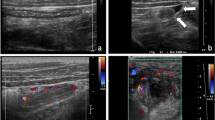Abstract
Objective
To determine if individual sonographers and radiologists impact appendix visualization by ultrasound and utilization of computed tomography (CT) in children with suspected acute appendicitis.
Materials and methods
Appendix ultrasound examinations performed at Cincinnati Children’s Hospital Medical Center on Emergency Department patients ≤ 18 years old were retrospectively identified. Examinations performed/interpreted by sonographers/radiologists with fewer than 100 examinations were excluded. Multivariable logistic regression was used to assess the effect of sonographer, radiologist, clinical variables, and system factors on imaging outcomes, including appendix visualization and subsequent CT utilization.
Results
A total of 9271 ultrasound examinations (mean [SD] patient age, 9.9 [4.2] years; 5392 [58.2%] boys) performed by 31 sonographers (mean number examinations, 299 [139]; range, 115–610) and interpreted by 31 radiologists (mean number examinations, 299 [157]; range, 101–845) were included. The mean frequency of appendix visualization per sonographer was 57.8% [8.7%] (range, 40.9–76.0%) and per radiologist was 59.5% [4.1%] (range, 51.7–66.3%). The mean rate of CT utilization per sonographer was 9.2% [2.0%] (range, 5.9–14.0%) and per radiologist was 9.2% [1.8%] (range, 3.4–12.1%). Predictors of appendix visualization by ultrasound included patient weight (p < 0.0001), sex (p = 0.0003), white blood cell count (p < 0.0001), temperature (p = 0.002), abdominal tenderness (p = 0.004), presence of appendicitis (p < 0.0001), sonographer (p < 0.0001), and radiologist (p = 0.02). Predictors of CT utilization included patient weight (p < 0.0001), white blood cell count (p < 0.0001), abdominal tenderness (p < 0.0001), rebound tenderness (p = 0.0003), and presence of appendicitis (p < 0.0001), but not sonographer or radiologist.
Conclusion
Individual sonographers and radiologists were associated with appendix visualization by ultrasound in children with suspected acute appendicitis; neither was associated with CT utilization.
Key Points
• Individual sonographers and radiologists are significantly and independently associated with appendix visualization by ultrasound in children with suspected acute appendicitis.
• Frequency of appendix visualization per sonographer demonstrated significant and wide variability across 31 sonographers, ranging from 40.9 to 76.0%.
• Fewer than 10% of patients with an ultrasound examination for suspected acute appendicitis underwent CT imaging within the following 24 h. Individual radiologists and sonographers were not predictive of CT utilization within 24 h.




Similar content being viewed by others
Abbreviations
- CT:
-
Computed tomography
- EMR:
-
Electronic medical record
- MRI:
-
Magnetic resonance imaging
- OR:
-
Odds ratio
- PACS:
-
Picture Archiving and Communication System
- RIS:
-
Radiology information system
References
U.S. Department of Health & Human Services. HUCPnet.
Expert Panel on Pediatric Imaging, Koberlein GC, Trout AT et al (2019) ACR Appropriateness Criteria((R)) Suspected Appendicitis-Child. J Am Coll Radiol 16:S252–S263
Trout AT, Sanchez R, Ladino-Torres MF, Pai DR, Strouse PJ (2012) A critical evaluation of US for the diagnosis of pediatric acute appendicitis in a real-life setting: how can we improve the diagnostic value of sonography? Pediatr Radiol 42:813–823
Strouse PJ (2010) Pediatric appendicitis: an argument for US. Radiology 255:8–13
Pinto F, Pinto A, Russo A et al (2013) Accuracy of ultrasonography in the diagnosis of acute appendicitis in adult patients: review of the literature. Crit Ultrasound J 5(Suppl 1):S2–S2
Davenport MS, Khalatbari S, Ellis JH, Cohan RH, Chong ST, Kocher KE (2018) Novel quality indicators for Radiologists interpreting abdominopelvic CT images: risk-adjusted outcomes among Emergency Department patients with right lower quadrant pain. AJR Am J Roentgenol 210:1292–1300
Davenport MS, Khalatbari S, Keshavarzi N et al (2020) Differences in outcomes associated with individual Radiologists for Emergency Department patients with headache imaged with CT: A retrospective cohort study of 25,596 patients. AJR Am J Roentgenol 1–8
Larson DB, Trout AT, Fierke SR, Towbin AJ (2015) Improvement in diagnostic accuracy of ultrasound of the pediatric appendix through the use of equivocal interpretive categories. AJR Am J Roentgenol 204:849–856
Mittal NK, Dayan PS, Macias CG et al (2013) Acad Emerg Med 20(7):697–702
Yigiter M, Kantarci M, Yalcin O, Yalcin A, Salman AB (2011) Does obesity limit the sonographic diagnosis of appendicitis in children? J Clin Ultrasound 39:187–190
Kaewlai R, Lertlumsakulsub W, Srichareon P (2015) Body mass index, pain score and Alvarado score are useful predictors of appendix visualization at ultrasound in adults. Ultrasound Med Biol 41:1605–1611
Athans BS, Depinet HE, Towbin AJ, Zhang Y, Zhang B, Trout AT (2016) Use of clinical data to predict appendicitis in patients with equivocal US findings. Radiology 280(2):557–567
Acknowledgements
We would like to acknowledge the Division of Biomedical Informatics at Cincinnati Children’s Hospital Medical Center, which provided in-kind support in the form of data collection. Research data services provided by the Division of Biomedical Informatics are partially supported by the Center for Clinical & Translational Science & Training (CCTST). This project was supported in part by the National Center for Advancing Translational Sciences of the National Institutes of Health under Award Number 5UL1TR001425-03. The content is solely the responsibility of the authors and does not necessarily represent the official views of the NIH.
Funding
The authors state that this work has not received any funding.
Author information
Authors and Affiliations
Corresponding author
Ethics declarations
Guarantor
The scientific guarantor of this publication is Jonathan Dillman, MD, MSc.
Conflict of interest
The authors of this manuscript declare no relationships with any companies, whose products or services may be related to the subject matter of the article.
Statistics and biometry
Bin Zhang, PhD kindly provided statistical advice for this manuscript.
Informed consent
Written informed consent was waived by the Institutional Review Board.
Ethical approval
Institutional Review Board approval was obtained.
Methodology
• retrospective,
• observational,
• single institution
Additional information
Publisher’s note
Springer Nature remains neutral with regard to jurisdictional claims in published maps and institutional affiliations.
Rights and permissions
About this article
Cite this article
Gilligan, L.A., Trout, A.T., Davenport, M.S. et al. Variation in imaging outcomes associated with individual sonographers and radiologists in pediatric acute appendicitis: a retrospective cohort of 9271 examinations. Eur Radiol 31, 8565–8577 (2021). https://doi.org/10.1007/s00330-021-07939-1
Received:
Revised:
Accepted:
Published:
Issue Date:
DOI: https://doi.org/10.1007/s00330-021-07939-1




